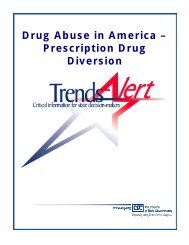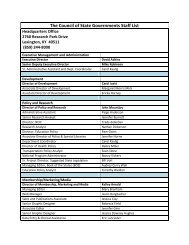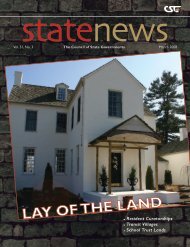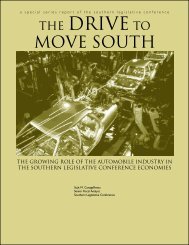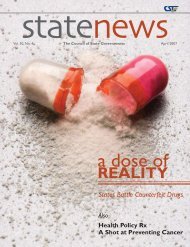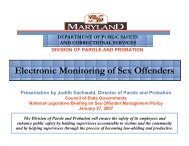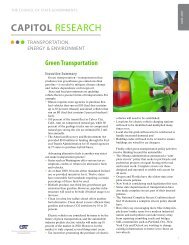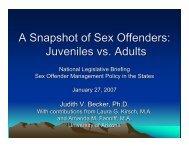Capitol Ideas - Council of State Governments
Capitol Ideas - Council of State Governments
Capitol Ideas - Council of State Governments
You also want an ePaper? Increase the reach of your titles
YUMPU automatically turns print PDFs into web optimized ePapers that Google loves.
CSG'S EXECUTIVE DIRECTOR | notes<br />
“the only thing more expensive than education is ignorance.”<br />
education holds a Miraculous and transformative Power<br />
With this issue <strong>of</strong> <strong>Capitol</strong> <strong>Ideas</strong> we go “back to school” with a focus on education. Education<br />
is perhaps the single most important function <strong>of</strong> state government. Getting education<br />
right is a high priority for the states. The challenges are great, but the cost <strong>of</strong> getting it<br />
wrong is one no state can afford to bear.<br />
The U.S. public education system consists <strong>of</strong> about 14,000 local school districts and nearly<br />
99,000 schools. In the 2007–08 school year, 48 percent <strong>of</strong> all revenues for public elementary<br />
and secondary education were provided by the states, while 44 percent came from local<br />
sources. More than three-fourths <strong>of</strong> this local portion was derived from local property<br />
taxes. The federal government contributed a relatively small share, just 8 percent.<br />
<strong>State</strong> spending for education has grown over the past decade. Total expenditures for<br />
public elementary and secondary education rose from about $334 billion in 1997–98 to<br />
roughly $597 billion in 2007–08, an increase <strong>of</strong> 79 percent—or 36 percent when adjusted<br />
for inflation. Per pupil expenditures, when adjusted for inflation, increased by 26 percent<br />
during the same time period.<br />
The budget crisis brought on by the economic downturn, however, has forced many states to cut education spending.<br />
<strong>State</strong> leaders know that an educated citizenry is essential for a self-governing society, for a well-trained workforce and for “life, liberty<br />
and the pursuit <strong>of</strong> happiness” to be enjoyed by all. Investments in education yield a solid return. A high school dropout will earn<br />
about $260,000 less than high school graduates and $800,000 less than college graduates in their lifetimes. High school dropouts<br />
have a life expectancy 9.2 years shorter than high school graduates. College graduates are three times more likely to vote than<br />
high school dropouts. Amazingly, research has shown, a one-year increase in average years <strong>of</strong> schooling for dropouts would reduce<br />
murder and assault rates by almost 30 percent, motor vehicle theft by 20 percent, arson by 13 percent, and burglary and larceny by<br />
almost 6 percent.<br />
The majority <strong>of</strong> a school district’s budget is spent on teachers. In 2007–08, the average salary for a teacher in the U.S. was $49,600.<br />
Primary and middle school teachers earn 61 percent <strong>of</strong> the average salaries paid to other U.S. employees with the same experience<br />
and a college education. High school teachers earn 65 percent. These ratios place our teachers near the bottom <strong>of</strong> the list when<br />
compared to ratios in other countries.<br />
Education reform is happening in the states. Forty-five states have agreed to adopt the Common Core <strong>State</strong> Standards and most<br />
<strong>of</strong> these states also have agreed to implement common assessments to measure students’ progress in learning the material in the<br />
standards. CSG is proud <strong>of</strong> the role we have played in convening state leaders to learn more about these reform efforts. You can read<br />
more about this effort in the pages that follow.<br />
While the statistics are telling, for me, education has always been a very personal pursuit. I can still name each <strong>of</strong> my elementary<br />
school teachers (and I’m guessing many <strong>of</strong> you can as well). These educators in Salina, Kan., had a pr<strong>of</strong>ound impact on my aspirations,<br />
my career and my enjoyment <strong>of</strong> life. They taught me to read, to write, to reason, and to work and play well with others. From<br />
my first day <strong>of</strong> kindergarten to my last days in law school, I was blessed with dedicated teachers whose passion for learning helped<br />
kindle my own pursuit <strong>of</strong> knowledge. As my own daughter, Nell, started sixth grade this fall, I saw in her the work <strong>of</strong> great educators.<br />
She is a self-confident, bright, articulate, courteous girl with a curiosity about the world around her. Her test scores tell me she is full<br />
<strong>of</strong> knowledge. Her outlook on life tells me she is full <strong>of</strong> wonder and wisdom. What a miraculous and transformative power education<br />
holds! Often the complexities <strong>of</strong> education policy fail to focus on the fundamental fact that a great teacher can have a pr<strong>of</strong>ound<br />
impact on the life <strong>of</strong> a child.<br />
CSG values the opportunity to educate state leaders about education—particularly what works in education today. We give state<br />
leaders lots <strong>of</strong> extra credit for the innovations they are pursuing in their states. We love sharing their success stories with you in this<br />
issue <strong>of</strong> <strong>Capitol</strong> <strong>Ideas</strong>. We hope you find this issue enlightening, and don’t worry, there won’t be a test.<br />
—Benjamin Franklin<br />
3<br />
CAPITOL IDEAS » SEPT / OCT 2012




